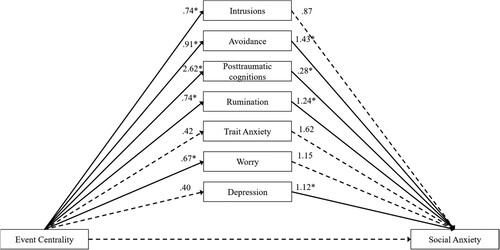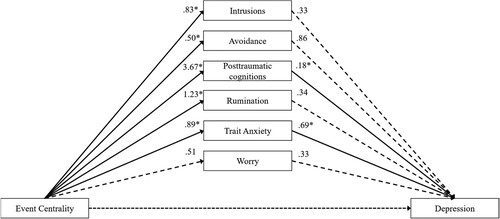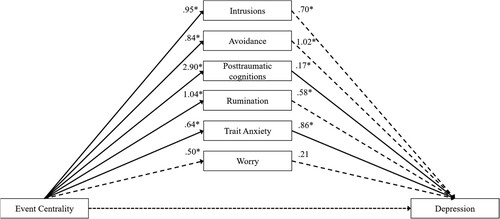Figures & data
Figure 1. Mediation analyses of the effect of event centrality on social anxiety symptoms through the different variables in the SAD sample.
Note: None of the variables significantly mediated the link between event centrality and social anxiety symptoms. Dotted lines represent non-significant betas. Total results of the Bayesian mediation analysis can be found in Table A4.

Figure 2. Mediation analyses of the effect of event centrality on depressive symptoms through the different variables in the MDD sample.
Note: Posttraumatic cognitions and Trait Anxiety mediated the link between event centrality and depressive symptoms. Dotted lines represent non-significant betas. Full results of the Bayesian mediation analysis can be found in Table A5.

Figure 3. Mediation analyses of the effect of event centrality on depressive symptoms through the different variables in the combined sample.
Note: All variables, except worry, mediated the relation between event centrality and depressive symptoms. Dotted lines represent non-significant betas. Full results of the Bayesian mediation analysis can be found in Table A6.

Table A1. Means and standard deviations of all variables in the two patient groups and differences between the two groups.
Table A2. Participant’s descriptives and between-group differences of participants who did or not report an onset event.
Table A3. Correlations between all variables within the two patient groups.
Table A4. Within-group mediation analysis for the relation between event centrality and SAD.
Table A5. Within-group mediation analysis for the relation between event centrality and MDD.
Table A6. Combined sample mediation analysis for the relation between event centrality (CES) and MDD.
Data availability statement
The data, materials, and analysis code that support the findings of this study are available from the corresponding author ([email protected]) upon reasonable request.
